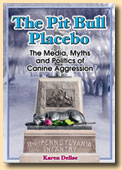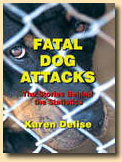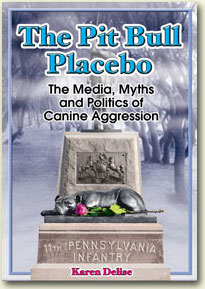 |
NEW!The Pit Bull Placebo:The Media, Myths and Politics of Canine Aggression |
 |
Fatal Dog Attacks:The Stories Behind the Statistics |
|
| |||
Two Books by Karen Delise explore the Facts, Fiction and
Statistics behind Dog Breeds and Dog Attacks

The Pit Bull Placebo:
The Media, Myths and Politics of Canine Aggression
By Karen Delise

“Falsehood flies and the truth comes limping after, so that when men come to be undeceived, it is too late: the jest is over, and the tale has had its effect.” - Jonathan Swift
First it was the Bloodhound, sensationalized in the dramatizations of Uncle Tom’s Cabin. Then it was the Doberman Pinscher, symbol of the Nazi menace for a nation at war. Today, it is the Pit bull that is vilified for the depravity of his master.
At perhaps no time in history has mankind been as ignorant of natural canine behavior as we find ourselves at the beginning of the 21st century. The human/dog bond—the most complex and profound inter-species relationship in the history of mankind—has now been reduced to a simple axiom: Breed of dog = degree of dangerousness.
Today, police chase down fleeing Pit bulls in the street, firing dozens of wild shots in response to media-fed rumors of supernatural Pit bull abilities. Politicians coach and nurture this fear with their own brand of rhetoric used to assist in the passing of quick and ineffective legislation created to pacify communities ignorant of the real cause for dog attacks. Hundreds of animal shelters throughout the country kill all unclaimed Pit bull-looking dogs, as they are deemed "unadoptable" solely on their physical appearance.
In a society unparalleled in its access to information and ability to control our natural environment, we now claim that we are unable to master our dogs. Unwilling to assume responsibility for the control and care of our canine companions, we instead hang entire breeds of dogs in effigy for the sins of their owners. Society now accepts this “solution to the dog bite problem” because we have been placated by a Pit Bull Placebo.
Like the pharmacologically inactive sugar pill dispensed to pacify a patient who supposes it to be medicine, eradication of the Pit bull is heralded as the cure for severe dog attacks. However, a placebo is administered solely to appease a person's mental duress. In the present day climate of fear and misinformation about Pit bulls and dog attacks, eradication of the Pit bull is the placebo administered to ease the public's mental anxiety. This, of course, does not address the underlying causes of why dogs attack and how they have been allowed access to their victims.
The book, The Pit Bull Placebo: The Media, Myths and Politics of Canine Aggression, explores and reveals how our views and beliefs about canine aggression have changed over the last 150 years and how our perceptions about the nature and behavior of dogs has been influenced and shaped by persons and organizations who often times disseminate information about dog attacks which is tailored to further an agenda unrelated to the improvement of the human/dog bond.
We have come to be in the midst of a social hysteria about Pit bulls because we have abandoned centuries-old common sense and reasoning and have been duped by inaccurate reporting from a media that thrives on sensationalism and by politicians who traffic in rumors, myths and pseudoscience in their efforts to pass legislation that demonizes dogs while exonerating criminal and abusive owners.
Despite the intense media, political and public interest in dog attacks, there is a disturbing scarcity of accurate information and investigation done on the real causes and reasons for these incidents.
If we truly believe that the extremely rare cases of fatal dog attacks merit extreme measures in the management of dogs—if our concern and shock is genuine—then we must be equally genuine and sincere in seeking out and addressing the real causes for these incidents.
Whether our goal is community safety, understanding canine behavior, furtherance of humane treatment towards dogs, or the advancement of the human-dog bond, it is critical that we examine all the details available about dog attacks.
The Pit Bull Placebo examines actual cases of severe dog attacks during the last 150 years—the circumstances, the individual dogs involved, the victims, and our interpretations of these events—in an attempt to offer a reasoned and balanced perspective on the behavior of dogs and the critical role humans play in the management and treatment of our canine companions.
Only by stepping back from the swirl of present-day hysteria surrounding isolated cases of severe canine aggression and examining the problem from a broader and more objective perspective can we hope to understand and effectively address the human and canine behaviors which have contributed to these incidents.
Information from this website is excerpted from the book: The Pit Bull Placebo: The Myths, Media and Politics of Canine Aggression, and is copy written by Karen Delise and Anubis Publishing.
![]()
The Pit Bull Placebo:
The Media, Myths and Politics of Canine
Aggression
By Karen Delise
Table of Contents
Introduction
Ch. 1. The Function of Dogs in 19th Century
America
Ch. 2. Imagery and the Media in 19th Century
America: The Bloodhound
Ch. 3. Creating Dangerous Dogs:
The Newfoundland & the Northern Breeds
Ch. 4. How
Popularity and Function Influence Aggression
Ch. 5. The
Reporting of Dog Attacks in Early 20th Century Media
Ch. 6.
The Use and Misuse of Courage: The Bulldog
Ch. 7. The
Media Re-Shapes an Image: The German Shepherd
Ch. 8. The
Myth of the Super-Predator: The Doberman Pinscher
Ch. 9.
Setting Dogs Up for Failure: The New Guard Dogs
Ch. 10.
The Media Attacks a Breed: The Pit Bull
Ch. 11.
Pseudoscience and Hysteria Triumph
Ch. 12. Fighting Dogs:
Branded with the Sins of Their Masters
Ch. 13. Sensationalism
Replaces Common Sense
Ch. 14. The Real Causes of Dog
Attacks
Ch. 15. The Pit Bull Placebo: Conclusions on Canine
Aggression
Appendix A - Dog Attacks Reported in Northeastern
Newspapers, 1864 – 1899
Appendix B - Dog Attacks Reported in U.S.
Newspapers, 1960 – 1975
Appendix C - Denver, Colorado – “Evidence” Used
to Ban Pit Bulls
Appendix D – Denver, Colorado – An Ineffective and
Uninformed Approach to Dog Attacks
Fatal Dog Attacks:
The Stories Behind the Statistics
By Karen Delise

"There is nothing to fear except the persistent refusal to find out the truth, the persistent refusal to analyze the causes of happenings." --Dorothy Thompson, (1894 - 1961)
Today’s media is filled with sensational headlines of dog attacks. Routinely quoted in these newspaper accounts are dated statistics from the Centers for Disease Control. The last CDC study released documented which breeds of dogs caused the most human fatalities from 1979 through 1998. While the CDC did an admirable job of studying fatal dog attacks, and went to great lengths to point out that irresponsible owners were the cause of most of these incidents, the media and lawmakers continue to use CDC statistics to substantiate claims that certain breeds of dogs are inherently more "vicious" than other breeds.
After reviewing over 431 cases of fatal dog attacks it is apparent there is no single factor that translates in a lethal encounter between a person and a dog(s). A fatal dog attack is always the culmination of past and present events that include: inherited and learned behaviors, genetics, breeding, socialization, function of the dog, physical condition and size of the dog, reproductive status of dog, popularity of breed, individual temperament, environmental stresses, owner responsibility, victim behavior, victim size and physical condition, timing and misfortune. While many circumstances may contribute to a fatal dog attack, the following three factors appear to play a critical role in the display of canine aggression towards humans;
- Function of the dog - (Includes: dogs acquired for fighting, guarding/protection or image enhancement)
- Owner responsibility - (Includes: dogs allowed to roam loose, chained dogs, dogs and/or children left unsupervised, dogs permitted or encouraged to behave aggressively, animal neglect and/or abuse)
- Reproductive status of dog - (Includes: unaltered males dogs, bitches with puppies, children coming between male dog and female dog in estrus)
It is necessary to emphasize that a fatal dog attack is an exceptionally rare event, yet many communities and cities believe that the solution to prevent severe and fatal dog attacks is to label, restrict or ban certain breeds of dogs as potentially dangerous. If the breed of dog was the primary or sole determining factor in a fatal dog attack, it would necessarily stand to reason that since there are literally millions of Rottweilers, Pit Bulls and German Shepherd Dogs in the United States, there would have to be countless more than an approximate 20-25 human fatalities per year. Since only an infinitesimal number of any breed is implicated in a human fatality, it is not only unreasonable to characterize this as a specific breed behavior by which judge an entire population of dogs, it also does little to prevent fatal or severe dog attacks as the real causes and events that contribute to a fatal attack are masked by the issue of breed and not seriously addressed.
From 1965 - 2001, there have been at least 36 different breeds/types of dog that have been involved in a fatal attack in the United States. (This number rises to at least 52 breeds/types when surveying fatal attacks worldwide). We are increasingly becoming a society that has less and less tolerance and understanding of natural canine behaviors. Breed specific behaviors that have been respected and selected for over the centuries are now often viewed as unnatural or dangerous. Dogs have throughout the centuries served as protectors and guardians of our property, possessions and families. Dogs have also been used for thousands of years to track, chase and hunt both large and small animals. These natural and selected-for canine behaviors seem to now eliciting fear, shock and a sense of distrust among many people.
There seems to be an ever growing expectation of a "behaviorally homogenized" dog - "Benji" in the shape of a Rottweiler. Breeds of dogs with greater protection instincts or an elevated prey-drive are often unfairly viewed as "aggressive or dangerous". No breed of dog is inherently vicious, as all breeds of dogs were created and are maintained exclusively to serve and co-exist with humans. The problem exists not within the breed of dog, but rather within the owners that fail to control, supervise, maintain and properly train the breed of dog they choose to keep.
Any dog, regardless of breed, is only as dangerous as his/her owner allows it to be.
This study was conducted not to determine which breeds of dogs caused fatalities, but rather to examine the circumstances and events that precipitated an attack. Knowing how many Pit Bulls or Rottweilers caused a human fatality has little applicable value, only when examining each case individually can we hope to gain insight into the HUMAN and CANINE behaviors that contributed to these tragic events. Only when we become more knowledgeable, humane and responsible in our treatment of dogs can we hope to prevent future tragedies.